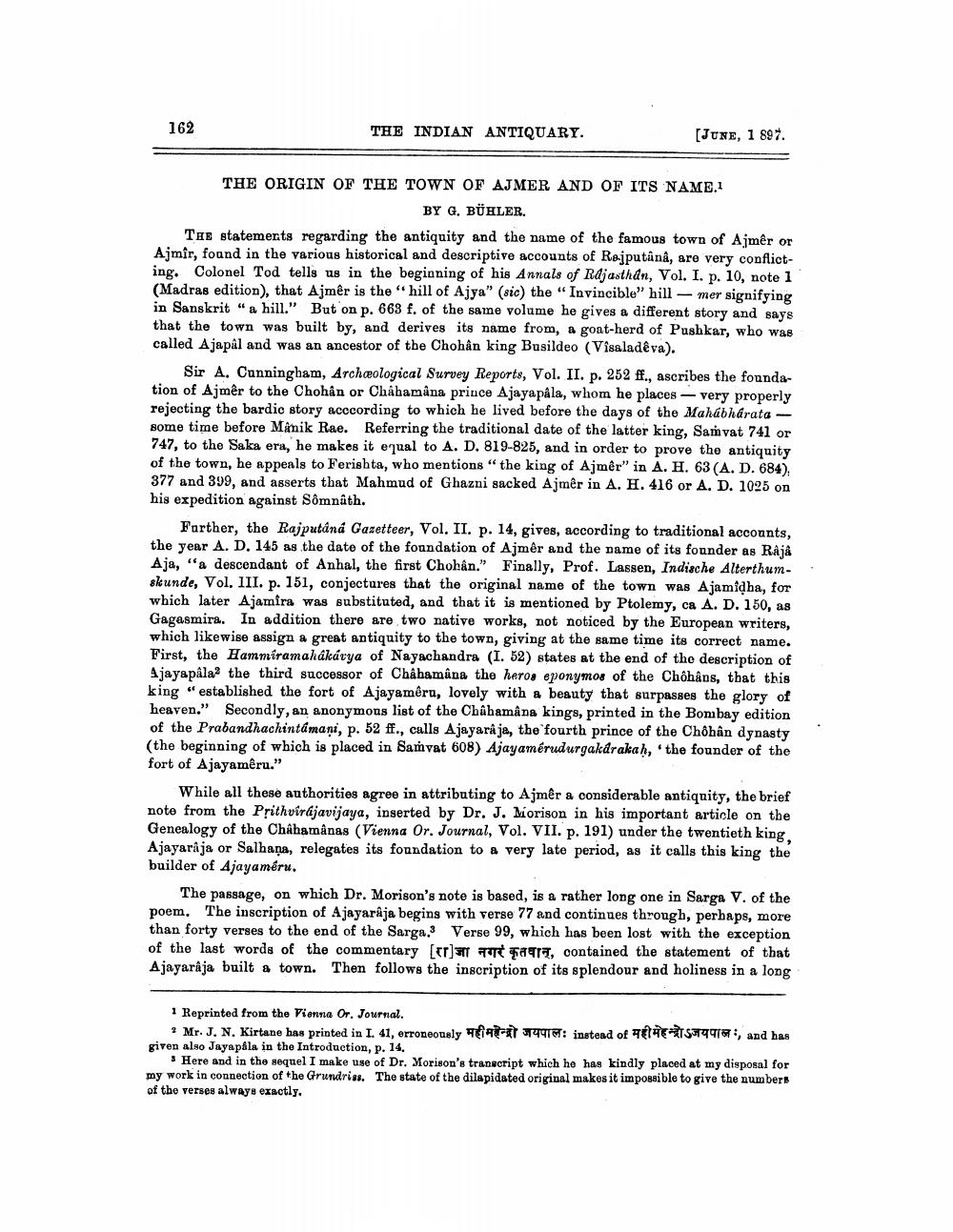________________
162
THE INDIAN ANTIQUARY.
(JUNE, 1 897.
THE ORIGIN OF THE TOWN OF AJMER AND OF ITS NAME.
BY G, BÜHLER. The statements regarding the antiquity and the name of the famous town of Ajmer or Ajmir, found in the various historical and descriptive accounts of Rajputânâ, are very conflicting. Colonel Tod tells us in the beginning of his Annals of Rajasthan, Vol. I. p. 10, note 1 (Madras edition), that Ajmêr is the hill of Ajya" (sic) the "Invincible" hill - mer signifying in Sanskrit "a hill." But on p. 663 f. of the same volume he gives a different story and says that the town was built by, and derives its name from, a goat-herd of Pushkar, who was called Ajapal and was an ancestor of the Chohân king Busildeo (Visaladêva).
Sir A. Cunningham, Archæological Survey Reports, Vol. II. p. 252 ff., ascribes the foundation of Ajmêr to the Chohan or Chåbamâna prince Ajayapala, whom he places - very properly rejecting the bardic story acccording to which he lived before the days of the Mahabharata - some time before Mimik Rae. Referring the traditional date of the latter king, Samvat 741 or 747, to the Saka era, he makes it equal to A. D. 819-825, and in order to prove the antiquity of the town, he appeals to Ferishta, who mentions "the king of Ajmer" in A. H. 63 (A. D. 684), 377 and 399, and asserts that Mahmud of Ghazni sacked Ajmêr in A. H. 416 or A. D. 1025 on his expedition against Somnath.
Farther, the Rajputâná Gazetteer, Vol. II. p. 14, gives, according to traditional accounts, the year A. D. 145 as the date of the foundation of Ajmêr and the name of its founder as Raja Aja, "a descendant of Anhal, the first Chohân." Finally, Prof. Lassen, Indische Alterthumskunde, Vol. III. p. 151, conjectures that the original name of the town was Ajamiąha, for which later Ajamira was substituted, and that it is mentioned by Ptolemy, ca A. D. 150, as Gagasmira. In addition there are two native works, not noticed by the European writers, which likewise assign a great antiquity to the town, giving at the same time its correct name. First, the Hammiramahákátya of Nayachandra (I. 52) states at the end of the description of Ajaya pala the third successor of Chahamâna the heros eponymos of the Chôhâns, that this king "established the fort of Ajayamêru, lovely with a beauty that surpasses the glory of heaven." Secondly, an anonymous list of the Châbamâna kings, printed in the Bombay edition of the Prabandhachintamani, p. 52 ff., calls Ajayaraja, the fourth prince of the Chöhân dynasty (the beginning of which is placed in Samvat 608) Ajayamērudurgakdrakah, the founder of the fort of Ajayamêru."
While all these authorities agree in attributing to Ajmêr a considerable antiquity, the brief note from the Prithvirkjavijaya, inserted by Dr. J. Morison in his important article on the Genealogy of the Chahamânas (Vienna Or. Journal, Vol. VII. p. 191) under the twentieth king. Ajayaraja or Salhaņa, relegates its foundation to a very late period, as it calls this king the builder of Ajayaméru.
The passage, on which Dr. Morison's note is based, is a rather long one in Sarga V. of the poem. The inscription of Ajayaraja begins with verse 77 and continues through, perhaps, more than forty verses to the end of the Sarga. Verse 99, which has been lost with the exception of the last words of the commentary [cr]HT TT art, contained the statement of that Ajayaraja built a town. Then follows the inscription of its splendour and holiness in a long
1 Reprinted from the Vienna Or. Journal.
Mr. J. N. Kirtane has printed in I. 41, erroneously HET ATT 74916: instead of TS 16, and has given also Jayapala in the Introduction, p. 14.
• Here and in the sequel I make use of Dr. Morison's transcript which he has kindly placed at my disposal for my work in connection of the Grundriss. The state of the dilapidated original makes it impossible to give the numbers of the verses always exactly,




